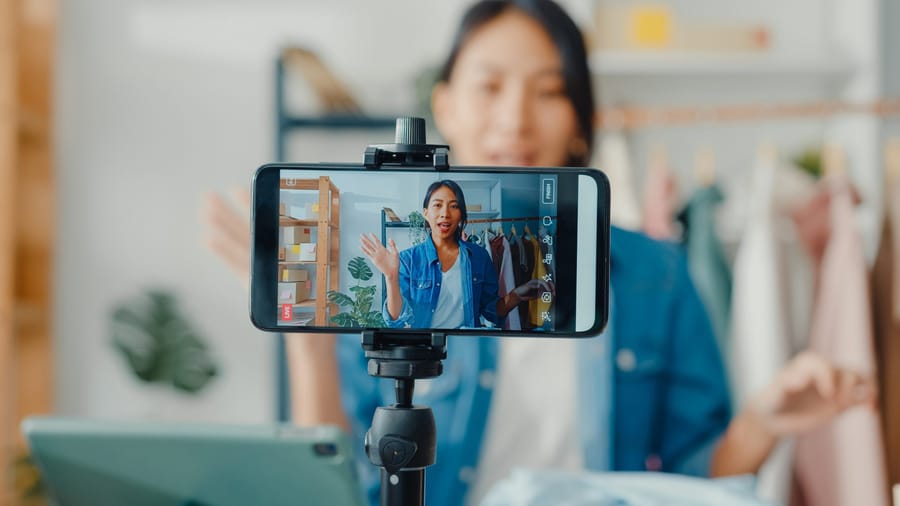Nikita was fascinated with the newly launched products of a skincare brand at the neighborhood mall but ended up purchasing them from the brand’s website. Alex, meanwhile, checked out a shoe brand’s website, but later found the right size on the brand’s mobile app.
What’s happening here? It’s omnichannel marketing at work.
According to Google, more than 90pc of customers switch between devices every day based on what’s functional or more convenient.
Today, customers can be reached through many platforms or locations, such as smartphones, desktop computers, laptops, tablets, mobile applications, emails, or brick-and-mortar stores.
The best brands use omnichannel campaigns and data-driven marketing trends to meet customers where they are.
What is omnichannel marketing?
Omnichannel marketing is an integrated approach that serves customers across multiple channels and platforms. Also known as multichannel marketing, it focuses on customers’ needs first. Every channel brings a unique value-add to the customer journey, offering a unified experience on any device.
Here are some examples of omnichannel marketing:
- Text message to a smartphone when a customer is shopping in-store
- Customers receiving an email about their abandoned e-commerce cart
- Retargeting ads after a customer visited the brand’s e-commerce website
Omnichannel vs. multichannel: What’s the difference?
Multichannel marketing is the ability to engage with a customer on different channels. Meanwhile, omnichannel marketing is an integrated approach that provides a seamless shopping experience to the customer.
- Omnichannel marketing example: A customer can shop on a website, mobile application, in-store, or via teleshopping and get a consistent experience on each channel.
- Multichannel marketing example: A company can reach the customer using a promotional in-store event, discount code on the website, or newspaper advertisement.
Here are some core differences between these two different marketing approaches:
- Customer vs. channels: Omnichannel marketing puts the customer first. It creates smooth touchpoints to build a stronger brand-customer relationship. In the multichannel approach, the focus is on using the maximum channels possible to reach the customer.
- Few vs. many channels: In omnichannel communication, brands make sure the messaging across every channel is consistent in enhancing brand loyalty, increasing brand recall, and developing stronger one-on-one relationships with customers. There is no similar approach in multichannel marketing, which aims to attract more customers with an increasing number of channels deployed for this purpose.
- Effort vs. seamless: Omnichannel marketing uses customer insights and data to make strategy creation and implementation effortless, removing any extra effort in the customer experience. In the multichannel approach, brands put in additional effort to set up multiple channels, increase engagement, and draw in more customers.
10 examples of great omnichannel marketing
Examples of omnichannel marketing are everywhere. Consider the customer who stands in a queue but ends up getting their coffee on the mobile app. Or another shopper who researches the latest shoe trends online but finds their perfect pair after walking into the physical store. Just a decade ago, such consumer behavior may have been considered absurd. Today, it is the norm.
Let’s take a look at a few popular brands and types of company types that use omnichannel marketing to improve their customers’ experience and satisfaction. We’ll look at companies from various industries, including entertainment, real estate, and fashion.
1. Omnichannel marketing strategy example in immersive entertainment
Let’s take Disney as our first example. Suppose Nina wants to go to Disneyworld with her family. She doesn’t need to go to the ticket booth at Disneyland or stand in a queue to get tickets — she can choose to buy the tickets online from the website or download Disney’s mobile app. She can scan Fastpasses for her entire family and check out maps and ride-wait times to plan the day. Disney has built a powerful omnichannel marketing solution with an interconnected and unified user experience.
2. Omnichannel marketing strategy example in sports and athleisure
Another example is Nike. The company uses a combination of social media, email marketing, and in-store events to promote new products and engage with customers. The brand also has a mobile app that allows its loyal, fitness-driven customers to track their workouts, order products, and gain access to exclusive content.
3. Omnichannel marketing strategy example in transportation and technology
Uber is another company with a great omnichannel marketing strategy. The ride-sharing app uses a combination of its mobile app, website, and offline ads to connect riders with drivers. It also uses email and push notifications to keep riders informed about their trips, offer promotions, and provide more convenience and value to both riders and drivers.
4. Omnichannel marketing strategy example in fashion and style
Many fashion brands use a mix of in-store promotions, email marketing, social media advertising, and influencer partnerships to promote their new products and collections. Some also create immersive digital experiences and virtual runway shows to attract more customers and wow a wider audience.
Zara, for example, uses in-store displays, social media, and email marketing to promote collections and drive sales. It also uses its website and mobile app to enable customers to place orders, pay, and track their deliveries. Meanwhile, Sephora’s mobile app offers personalized recommendations and virtual try-on experiences. It also allows customers to gain and use loyalty points within the app and shops.
5. Omnichannel marketing strategy example in entertainment and media streaming
Streaming giant Netflix uses a combination of content recommendations, email marketing, and social media to promote its service and keep customers entertained. The company is intensely data-driven and personalizes the experience for each user based on their past behaviors, movie choices, and geographical locations.
Small and mid-sized media streaming companies and solo creators also use multifaceted marketing campaigns to promote new movies and shows. This includes creating a dedicated website and social media accounts for each new show or movie, running targeted ads on social platforms, and partnering with other streaming platforms and influencers to create and distribute content and drive buzz.
6. Omnichannel marketing strategy example in food and drink
Many food and drink companies and restaurants combine mobile ordering and delivery, email, and social media marketing to make it easy for customers to place and receive their orders. They also have rating systems for businesses and loyalty programs to reward customers for large or repeat orders.
Starbucks uses these methods to drive sales and improve its customer experience. Customers can place an order, pay through the Starbucks app, and pick it up at a nearby store. The loyalty program enables customers to earn rewards and customize their orders.
7. Omnichannel marketing strategy example in real estate and housing development
Today’s real estate companies and developers use a combination of offline and online ads, email, and social media to promote new housing developments. They can also host open house events for committed buyers, offer virtual tours to interested ones, and connect widely with potential homeowners in innovative ways.
A real estate company may partner with local businesses and influencers to host community events — for example, exhibiting the best local art in an open house to attract viewers, build community, and show off local creative talent.
8. Omnichannel marketing strategy example in construction
Construction companies can launch new lines of building materials and promote them through a mix of trade shows, press releases, and targeted online ads to attract architects and builders. They can also create a series of informative videos and publish them on their website and social media channels.
Vehicle signage and promotional materials (e.g., pens, keychains, and T-shirts) are old-fashioned but solid marketing strategies to create a complete omnichannel marketing strategy for construction companies.
9. Omnichannel marketing strategy example in health and medical
Omnichannel marketing in the health and medical space is growing as fast as other industries. Hospitals, pharmacies, and other players in the space use email marketing, targeted online ads, and social media to promote services and educate patients about their specialties.
They also hold health and wellness seminars and workshops within their communities to connect with potential patients and spread awareness about better health management.
10. Omnichannel marketing strategy example in the home and styling industry
Ikea is an excellent example of a home and decor company maximizing omnichannel marketing strategies to boost sales. The company uses online and offline channels to provide a seamless shopping experience for customers.
The website and mobile app enable customers to view products, place orders and track their deliveries. Ikea also has physical stores where customers can see and test products before buying.
Tips for omnichannel communication
Before creating an omnichannel marketing campaign, identify the key stakeholders across the organization. These teams should be a part of any omnichannel strategy process:
- Marketing
- Product
- Customer Support
- Sales
Start with cross-team collaboration
Schedule a time with key members from these teams to assess, plan, and begin executing a transition to the new omnichannel marketing model.
Once the teams agree on the primary marketing goals and metrics, they can go after stakeholder buy-in and begin delegating tasks to mid-level managers and specific team members to make progress tracking and collaboration easier.
Marketing teams
Each organization’s marketing team is different. Some include various separated units within them, e.g., events marketing, content marketing, advertising, and branding teams. In other cases, all arms of marketing are integrated into one. The senior marketing director manages other managers covering different aspects of the company’s online and offline marketing.
Make sure the marketing team director, managers, and key team members are in the omnichannel marketing strategy meetings from the start. They are there to represent the customers and put their needs and expectations front and center as plans are made.
The main role of the marketing team in omnichannel marketing strategy is to communicate and prioritize the customers’ needs, satisfaction, and understanding of the company’s offerings. They ensure all marketing messaging and copy are aligned and communicate the same message regardless of the channel, medium, or device their customers use.
Product teams
Effective omnichannel marketing goes further than the efforts of the marketing team. The product team is the foundation of all customer value created in an organization.
Product team leaders must be part of the omnichannel marketing strategy meetings from the start to highlight the organization’s currently available products, platforms, and services as well as what is needed to achieve an improved and cohesive omnichannel experience.
They assess how quickly requests can be completed and changes made to maintain a seamless user experience throughout the transition. The role of product teams in omnichannel marketing includes:
- Crafting and taking responsibility for the product strategy
- Developing a realistic product roadmap
- Communicating the product roadmap to stakeholders and other involved teams to keep everyone working on schedule
Sales teams
The sales team helps to analyze the organization’s commercial front. They align the organization’s strategic objectives with its marketing goals, responsibilities, and projects.
Sales team leaders and managers optimize and define the commercial and sales channels and platforms best fit for the organization. They identify market trends and communicate customers’ changing needs and expectations. They also manage resources and competencies to achieve the set sales target in the new omnichannel strategy.
Other responsibilities of the sales team in omnichannel marketing include:
- Offering input on pricing, negotiation, and customer responses
- Developing trusting relationships with customers and inbounds that generate long-term, more satisfying business relationships
- Defining new sales profiles and hiring sales reps aligned with the organization’s culture
Customer support teams
Omnichannel customer service teams work to synchronize an organization’s customer-facing support channels to deliver consistent support in a way that fosters ease, convenience, continuity, and less hassle for the end customers.
Customer service supervisors and teams bring helpful feedback to improve the omnichannel strategy, helping the other teams understand customers’ real problems and hiccups throughout each stage of the customer life cycle. They are able to derive insights from their customer conversation history and deliver better, personalized support by integrating active channels in the organization’s omnichannel model.

Streamline your cross-team communication
Bringing the essential teams together is only the start of the process of creating an effective omnichannel marketing strategy. Next, you must design a workflow with timelines to streamline cross-team collaboration to enhance productivity and track overall progress.
An online team collaboration software platform such as Wrike is excellent for omnichannel marketing teams of all sizes — from enterprise project management to scaling startups, creative collaborators, and solo entrepreneurs. A team collaboration platform provides a virtual workspace and a single source of truth for all omnichannel marketing-related planning, conversations, progress tracking, execution, and review.
Review customer experience
Spend time reviewing all touchpoints that potential shoppers would go through in their customer journey, from product research to engaging with products to completing the final purchase.
Make sure to test the entire user experience using internal, neutral third-party testers to discover areas of improvement.
Take a data-driven approach
Monitoring metrics is absolutely essential in discovering which customer touchpoints are the most effective. For example, if a potential shopper finds a brand’s website but completes the purchase in the retail store, your marketing technology should be able to attribute the sale correctly.
Customer journeys are multifaceted and may span multiple devices across multiple days. Carefully and accurately capturing these touchpoints can help you invest in the right channels and identify which are significantly contributing to brand revenues, profits, and growth.
Focus on mobile
According to Think With Google research, 96pc of consumers use their smartphones to find information about anything they want to do, buy, rent, or use.
Brands need to connect their information across channels, but especially mobile, to craft a compelling omnichannel strategy.
By understanding consumer behavior and anticipating their needs, brands can ensure that real value is delivered in micro-moments. For example, introducing personalized push notifications may be one way to boost engagement with dormant users.
Provide self-serve options
Providing self-serve options across channels is key. Research suggests that customers of all ages prefer finding answers to questions themselves.
Even with wide demographic shifts and changing preferences, understanding customer behavior is key in implementing an omnichannel marketing strategy.
Be available across preferred channels
Customers are increasingly using multiple channels or touchpoints, even in a single transaction. This can include visiting a store, searching on Google, downloading and browsing on a brand’s mobile app, or even browsing a competitor’s website or mobile application.
Brands need to pay attention and have a strategy in place to respond appropriately to these interactions.
For example, a customer on their laptop may add a product to their cart when browsing on the brand’s website. If they wish to complete their transaction on their iPad, it should be visible to them when they log in.
What are the benefits of omnichannel marketing solutions?
Even as most brick-and-mortar retailers struggled to grow their sales during the pandemic, one company recorded the best revenue numbers in its history.
Leading US retailer Target booked its best quarterly numbers in the second quarter of 2020 with a 24pc increase in total sales. Remarkably, it also saw digital sales grow by a phenomenal 195pc. Thanks to the seamless introduction of an omnichannel strategy, Target successfully integrated its digital and physical presence.
It also found that omnichannel customers who use retail stores, mobile, and online to purchase spent ten times more than online-only customers and four times more than store-only buyers.
We know that the pandemic has fast-tracked digitalization. The key to marketing success lies in bringing together the physical and digital worlds to create quality customer experiences. Creating consistent branding and service touchpoints across different channels is essential if brands want to stay competitive.
Here are some of the benefits of omnichannel marketing:
Boosts customer retention and loyalty
Customers prefer purchasing from brands they trust. Offering personalized and amalgamated omnichannel communication helps create strong customer-brand relationships, increases trust, and boosts customer retention.
A study from HBR reaffirms that omnichannel customers are also more loyal. Within six months of an omnichannel experience, they’re likely to recommend that brand to their family and friends and make repeat shopping trips themselves.
Brands understand the value of keeping customers coming back for more. Omnichannel campaigns can be very valuable in retaining this lifetime value. By leveraging customer relationships and related data, brands can create informed conversion strategies, customize customer service, and increase brand loyalty.
Improves brand recall
New buzzwords are emerging every day due to evolving customer behavior and market trends. The rise of ’webrooming’ and ’showrooming’ is a case in point.
Shopify’s research confirms that more than 71pc of customers do product research online even though the resultant purchase may be made offline.
Showrooming is when a consumer checks out a product in a physical store but makes the purchase online. Webrooming is when a customer does product research online but completes the final product evaluation and purchase at the retail store.
By emphasizing omnichannel marketing campaigns, companies can project a holistic and consistent brand across all devices and platforms. This can vastly reinforce brand recall and increase the likelihood of customers purchasing from them.
Realizes increases in revenue
Omnichannel customers who engage with four or more marketing channels spend 9pc more than the average single-channel shopper.
Research from the Interactive Advertising Bureau validates this increase in revenue generated by omnichannel shoppers, with a study showing that consistent messaging across various channels could increase consumer purchase intent by a whopping 90pc.
It’s clear that omnichannel communication can drive repeat purchases, increase order values, and enhance revenues and profits.
Better customer segmentation and targeting
Having an omnichannel communication strategy also helps brands understand their customers’ wants, including their likes and specific preferences.
Performing a detailed assessment of customer data enables teams to segment customers based on specific demographic factors such as age, gender, preferences, and different user intent.
For example, let’s assume a customer just purchased a modular kitchen from your brand. Don’t keep showing them online ads for the same product — move on to upselling or cross-selling to subtly nudge them with advertisements for ancillary items such as kitchen accessories or small appliances.
Increase in campaign ROI
All marketers want a solid return on their investment (ROI). Without a strong funnel in place, no marketing strategy can work. Planning, creating, and implementing an omnichannel marketing strategy helps your brand have a powerful marketing funnel that can significantly improve ROI.
Brands can use contextual messaging, tailored product recommendations, and multiple devices to provide interconnected user experiences and obtain a higher campaign ROI.
For example, with a website campaign, the marketing team can set up a powerful retargeting strategy to reduce site drop-offs. They can send abandoned cart emails to a potential customer who spent time browsing but did not complete the purchase.
Another option could be using search display ads on Google to show discount codes, prompting the customer to complete their purchase.
How can I develop a successful omnichannel marketing strategy for campaigns?
Did you know that today, the average customer needs six touchpoints before they buy a product? 15 years ago, they needed just two.
It’s never been more important to have an omnichannel marketing strategy. But how do you go about creating an omnichannel campaign that’s successful and integrated at the same time?
Review the customer touchpoints
One of the most intuitive ways to start the process is by understanding your customers and their unique journeys.
Think like a customer. Check out every touchpoint that a typical buyer would come across when discovering your brand, even before purchasing anything. Notice if communication is seamless across the different channels.
Choose a suitable marketing technology
Choose the right omnichannel marketing tool to connect with your customers. Ensure that the selected technology is easy to use, fits your company’s unique needs, and integrates with the existing company software.
To deliver high-performing campaigns within budgets and timelines, you need a work management platform such as Wrike, which is designed for marketers.
With Wrike, brands get complete visibility into valuable campaign insights from search, social media, and display and digital campaign performance results within their dashboards.
Practice customer segmentation
Take the time to create multiple relevant buyer personas and discover target audiences by closely assessing their needs, wants, behaviors, preferences, goals, and other demographic factors.
Do primary research and leverage the secondary customer insights and data available to observe customers and look for any behavior patterns. Remember to store this valuable research in a versatile work management platform like Wrike, which acts as a robust business intelligence tool.
Wrike helps teams to create visual and dynamic reports that keep stakeholders informed and offers premade templates for marketing campaign management.
Hyper-localize across channels
A HBR survey of 46,000 shoppers revealed that:
- 20pc people were store-only buyers
- 7pc were online-only shoppers
- 73pc classify themselves as omnichannel shoppers
The omnichannel shoppers used the brand’s touchpoints in multiple combinations and orders. For example, one customer would browse online, then complete the purchase in-store.
Another customer may walk into the store but make the purchase on the brand’s mobile app. In such situations, delivering a smooth, localized marketing experience can work wonders.
Using the right automation, data insights, and consumer knowledge, brands can establish a one-on-one relationship with their target audience.
Use the right metrics to monitor campaign success
Did you know that companies using data-driven marketing strategies report a five-time increase in marketing campaign ROI?
Brands can do this by setting up and tracking the key metrics. For your next marketing campaign launch, identify the key metrics that need to be tracked. Consistently monitoring these data points will provide your team with accurate data and actionable insights for an omnichannel approach.
Utilize these data-driven insights and information to make suitable revisions to company strategy across social media, marketing, and advertising campaigns.
How to plan your omnichannel marketing campaign with Wrike
Though an average consumer’s path to purchase may be complex, your omnichannel marketing campaign can be simple. Even this seemingly challenging customer journey can be broken down into smaller steps that help reveal why, where, what, and how consumers decide to buy.
With Wrike, it’s easy to create a holistic omnichannel marketing operation by employing custom request forms, visually tracking marketing metrics in custom dashboards, and keeping management informed with on-demand reports.
Unify all campaign assets, files, and folders in one seamless workspace that allows for easy collaboration amongst various teams.
Wrike lets you streamline your workflows and integrates uniformly with leading DAM tools to help teams create and provide on-brand assets faster. Start a free two-week trial of Wrike and see how we can help you deliver your next omnichannel marketing campaign more efficiently.








